Bis 2c Study guides, Class notes & Summaries
Looking for the best study guides, study notes and summaries about Bis 2c? On this page you'll find 40 study documents about Bis 2c.
Page 4 out of 40 results
Sort by

-
Pre-lab #3 | Completed - University of California, Davis BIS 2C 2C
- Exam (elaborations) • 13 pages • 2023
- Available in package deal
-
- $9.49
- + learn more
Most often, eukaryotes call to mind large and conspicuous animals and plants, but there are many eukaryotes that are not visible to the naked eye. Recall from lab 2 that the word ‘microbe’ is used to refer to microscopic organisms in any of the domains and viruses. In lab 3, you will be introduced to microbial eukaryotes, a group that includes several disparate lineages with diverse ecology and life history. The occur in most habitats worldwide, are key players in symbiotic interactions,...
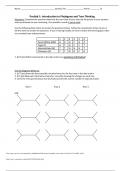
-
BIS 2C Postlab 1: Introduction to Phylogeny and Tree-Thinking (Graded A+)
- Exam (elaborations) • 2 pages • 2023
- Available in package deal
-
- $7.99
- + learn more
Postlab 1: Introduction to Phylogeny and Tree-Thinking Directions: Complete the questions below by the start time of your next lab. Be precise in your answers and pay attention to your reasoning. Your postlab is worth 5 points total. Use the following data matrix to answer the questions below. Follow the conventions shown to you in lab this week to answer the questions. If you’re having trouble, be sure to watch the learning glass video on unrooted trees and parsimony. 1 2 3 4 5 6 Great...
BIS 2C – LAB PRACTICAL - ALL BIS 2C LAB PRACTICALS QUESTIONS AND ANSWERS
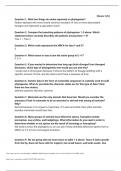
-
BIS 2C 002C Pre-lab 1 | 2023 | All Answers are Corrected
- Exam (elaborations) • 3 pages • 2023
- Available in package deal
-
- $10.49
- + learn more
Question 1. What two things do nodes represent on phylogenies? Nodes represent the most recent common ancestor of two or more descendant lineages and represent a speciation event. Question 2. Compare the branching patterns of phylogenies 1-3 above. Which statement below correctly describes the patterns among trees 1-3? Tree 1 = Tree 2 Question 3. Which node represents the MRCA for taxa F and G? 3 Question 4. Which taxon or taxa is/are the sister group to E + F? D, G, H Questi
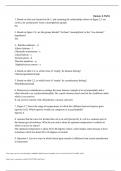
-
BIS 2C 002C Pre-lab 2 | 2023 | All Answers are Corrected
- Exam (elaborations) • 2 pages • 2023
- Available in package deal
-
- $9.49
- + learn more
1. Based on what you learned in lab 1, and assuming the relationships shown in figure 2.1 are correct, do ‘prokaryotes’ form a monophyletic group? No 2. Based on figure 2.2, are the groups labeled “Archaea” monophyletic in the “two-domain” hypothesis? Yes 3. Bacillus anthracis - d Vibrio cholerae - f Chlamydia trachomatis - e Lokiarchaeota - c Yersinia pestis - b Thermus aquaticus - g Staphylococcus aureus - a 4. Based on table 2.2, to which class of ‘trophy’ do hum...
This is a comprehensive and detailed note on Non vascular plants for Bis 2c. Quality stuff!! U'll need it for effective study!?
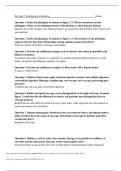
-
BIS 2C 002C Pre-lab 7 (QUESTIONS AND ANSWERS)Pre-Lab 7: Introduction to Metazoa
- Exam (elaborations) • 2 pages • 2023
-
- $9.49
- + learn more
Pre-Lab 7: Introduction to Metazoa (Score: Question 1. Study the phylogeny of animals in figure 7.3. Where are humans on this phylogeny? What are the defining features of the phylum to which humans belong? Humans are on the chordata. The defining features are notochord, dorsal hollow nerve chord, and post-anal tail. Question 2. Study the phylogeny of animals in figure 7.3. What feature of the phylogeny supports the fact that deep relationships among animals remain unresolved? Polytomy:sho...

-
BIS 2C 002C Pre-lab 4: Introduction to Plant Diversity I
- Exam (elaborations) • 2 pages • 2023
- Available in package deal
-
- $9.49
- + learn more
Pre-lab 4: Introduction to Plant Diversity I
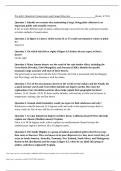
-
BIS 2C 002C Pre-lab 6: Botanical Conservatory and Fungal Diversity
- Exam (elaborations) • 3 pages • 2023
- Available in package deal
-
- $9.49
- + learn more
Pre-lab 6: Botanical Conservatory and Fungal Diversity (Score: 4.75/5) Question 1. Identify two reasons why maintaining a large, living plant collection is an important public and scientific resource. It lets us study different types of plants without having to travel all over the world and it teaches us better methods of conservation. Question 2. In figure 6.2 above, which season (X or Y) would correspond to winter at point A? Season X Question 3. On which side (left or right) of figure...

-
BIS 2C “Biodiversity and The Tree of Life” Midterm 2 Study Guide: Plantae Lineage
- Exam (elaborations) • 28 pages • 2022
-
- $16.49
- + learn more
BIS 2C “Biodiversity and The Tree of Life” Midterm 2 Study Guide: Plantae Lineage The Non-vascular plants-Bryophytes/Embryophytes: 1. Early non-vascular plants including Charates and Coleochaete (outgroup-streptophytes) had phragmoplast, branched filaments, apical growth (meristems), and oogamy. 2. Bryophyte: A small flowerless green plant of the division Bryophyta, which compromises the Mosses (Polytrichum), Hornwort (Anthoceros), and Liverworts. • Traditional name used to refer ...

Do you wonder why so many students wear nice clothes, have money to spare and enjoy tons of free time? Well, they sell on Stuvia! Imagine your study notes being downloaded a dozen times for $15 each. Every. Single. Day. Discover all about earning on Stuvia



